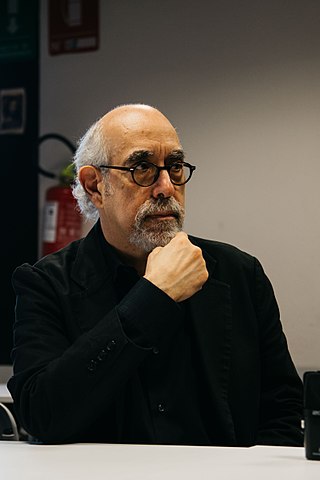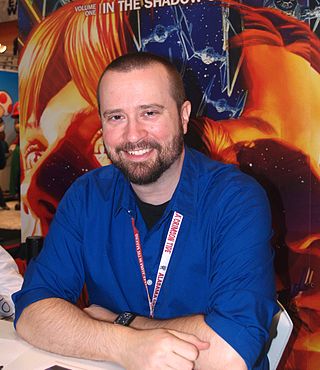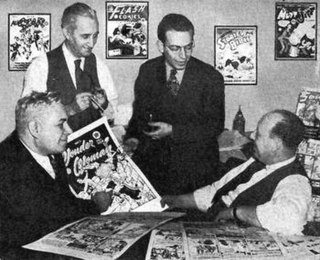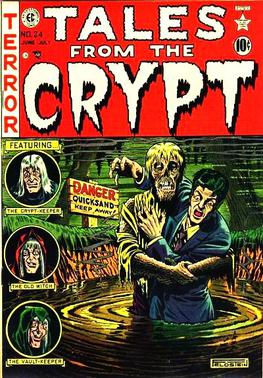
William Moulton Marston, also known by the pen name Charles Moulton, was an American psychologist who, with his wife Elizabeth Holloway, invented an early prototype of the polygraph. He was also known as a self-help author and comic book writer who created the character Wonder Woman.
A graphic novel is a long-form work of sequential art. The term graphic novel is often applied broadly, including fiction, non-fiction, and anthologized work, though this practice is highly contested by comics scholars and industry professionals. It is, at least in the United States, typically distinct from the term comic book, which is generally used for comics periodicals and trade paperbacks.
Publication of comic strips and comic books focusing on science fiction became increasingly common during the early 1930s in newspapers published in the United States. They have since spread to many countries around the world.

John Marc DeMatteis is an American writer of comic books, television and novels.

An American comic book is a thin periodical originating in the United States, on average 32 pages, containing comics. While the form originated in 1933, American comic books first gained popularity after the 1938 publication of Action Comics, which included the debut of the superhero Superman. This was followed by a superhero boom that lasted until the end of World War II. After the war, while superheroes were marginalized, the comic book industry rapidly expanded and genres such as horror, crime, science fiction and romance became popular. The 1950s saw a gradual decline, due to a shift away from print media in the wake of television and the impact of the Comics Code Authority. The late 1950s and the 1960s saw a superhero revival and superheroes remained the dominant character archetype throughout the late 20th century into the 21st century.
Titan Publishing Group is the publishing division of the British entertainment company Titan Entertainment, which was established as Titan Books in 1981. The books division has two main areas of publishing: film and television tie-ins and cinema reference books; and graphic novels and comics references and art titles. Its imprints are Titan Books, Titan Comics and Titan Magazines.

Kyle John Baker is an American cartoonist, comic book writer-artist, and animator known for his graphic novels and for a 2000s revival of the series Plastic Man.
The Amalgamated Press (AP) was a British newspaper and magazine publishing company founded by journalist and entrepreneur Alfred Harmsworth (1865–1922) in 1901, gathering his many publishing ventures together under one banner. At one point the largest publishing company in the world, AP employed writers such as Arthur Mee, John Alexander Hammerton, Edwy Searles Brooks, and Charles Hamilton. Its subsidiary, the Educational Book Company, published The Harmsworth Self-Educator, The Children's Encyclopædia, and Harmsworth's Universal Encyclopaedia. The company's newspapers included the Daily Mail, the Daily Mirror, The Evening News, The Observer, and The Times. At its height, AP published over 70 magazines and operated three large printing works and paper mills in South London.

Otto Oscar Binder was an American author of science fiction and non-fiction books and stories, and comic books. He is best known as the co-creator of Supergirl and for his many scripts for Captain Marvel Adventures and other stories involving the entire superhero Marvel Family. He was prolific in the comic book field and is credited with writing over 4,400 stories across a variety of publishers under his own name, as well as more than 160 stories under the pen-name Eando Binder.

Paul Kupperberg is an American writer and comics editor. He is currently a writer and executive editor at Charlton Neo Comics and Pix-C Webcomics, and a contributing author with Crazy 8 Press. Formerly, he was an editor for DC Comics and executive editor of Weekly World News, as well as a writer of novels, comic books, and newspaper strips.
Robert Kanigher was an American comic book writer and editor whose career spanned five decades. He was involved with the Wonder Woman franchise for over twenty years, taking over the scripting from creator William Moulton Marston. In addition, Kanigher spent many years in charge of DC Comics's war titles and created the character Sgt. Rock. Kanigher scripted what is considered the first Silver Age comic book story, "Mystery of the Human Thunderbolt!", which introduced the Barry Allen version of the Flash in Showcase #4.

Trina Robbins is an American cartoonist. She was an early participant in the underground comix movement, and one of the first female artists in that movement. She is a member of the Will Eisner Hall of Fame.

Dan Jolley is an American novelist and comic book writer. His comics work includes DC Comics' Firestorm and Graphic Universe's Twisted Journeys, a series of interactive fiction or gamebooks in graphic novel form, and his novel work includes the young-adult science fiction espionage series Alex Unlimited along with his international best selling novel, The Gray Widow's Walk, which is his first book in the Gray Widow trilogy that he publishes through Seventh Star Press. He created the comic book character Jason Rusch with ChrisCross.
M. K. Brown is an American cartoonist and painter whose work has appeared in many publications, including National Lampoon (1972–1981), Mother Jones, Wimmen's Comix, The New Yorker, Playboy, among others. She has written several books, created animations for The Tracey Ullman Show, and was a contributing artist to the "comic jam" graphic novel The Narrative Corpse. She is also an accomplished painter with work in galleries and many private collections.

Harry George Peter was an American newspaper illustrator and cartoonist known for his work on the Wonder Woman comic book and for Bud Fisher of the San Francisco Chronicle.
The portrayal of women inAmerican comic books has often been the subject of controversy since the medium's beginning. Critics have noted the roles of women as both supporting characters and lead characters are substantially more subjected to gender stereotypes, with femininity and/or sexual characteristics having a larger presence in their overall character.

Horror comics are comic books, graphic novels, black-and-white comics magazines, and manga focusing on horror fiction. In the US market, horror comic books reached a peak in the late 1940s through the mid-1950s, when concern over content and the imposition of the self-censorship Comics Code Authority contributed to the demise of many titles and the toning down of others. Black-and-white horror-comics magazines, which did not fall under the Code, flourished from the mid-1960s through the early 1980s from a variety of publishers. Mainstream American color comic books experienced a horror resurgence in the 1970s, following a loosening of the Code. While the genre has had greater and lesser periods of popularity, it occupies a firm niche in comics as of the 2010s.

Non-fiction comics, also known as graphic non-fiction, is non-fiction in the comics medium, embracing a variety of formats from comic strips to trade paperbacks.

Josette Frank was an American children's literature expert and educational consultant. Frank spent most of her adult life working for the Child Study Association of America (CSAA), a leading authority on child development from the 1920s to the 1960s. Frank was engaged as the CSAA's child reading expert and published a parental literary guide titled What Books For Children? in 1937 with a new edition in 1941. Due to her progressive views about parental supervision of children's reading, Frank became one of the significant pro-comics voices during the American anti-comics movement of the 1950s, for which she received praise and criticism.

Real Fact Comics is a series of educational American comic books published by three early iterations of DC Comics: World's Best Comics, Inc., Detective Comics, Inc., and National Comics Publications. The series lasted for 21 issues with cover dates from March/April 1946 to July/August 1949. Like most educational comics besides the Parents' Magazine Institute's flagship series, True Comics, the series suffered from poor sales.













